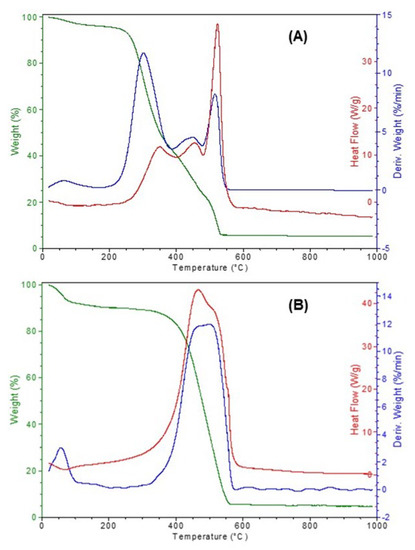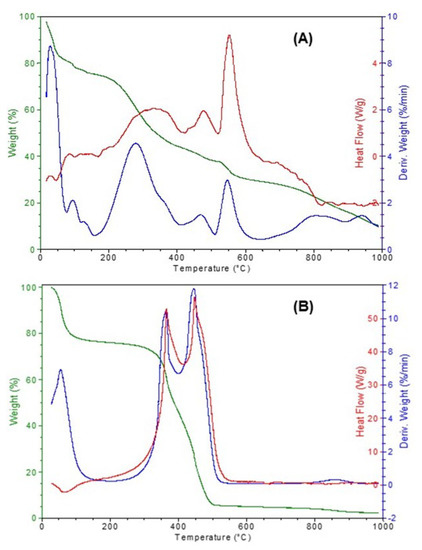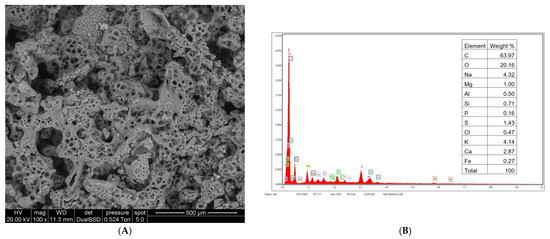Abstract
Resource depletion and climate change have fostered sustainable initiatives in the waste management sector. Pyrolysis (Py) has emerged as an option for valorizing spent coffee grounds (SCG). In addition, inorganic compounds can have catalytic effects on the pyrolytic reaction of organic materials, increasing the char yield and porosity of biochar. This study investigates the slow pyrolysis of SCG using concentrated landfill leachate residue (CLLR) (1:1 wt%) as a pyrolitic additive due to its high salinity. Biochars were characterized based on their thermal behavior to discuss environmental benefits and potential applications. Slow-py experiments were conducted using a lab-scale pyrolizer, and thermal characterization was performed using TA Instruments, specifically the SDTQ600 model. Biochars were characterized by higher water contents and heating rates than those experienced by their feedstocks. It is suggested that the high metal content of CLLR could change the biochar’s thermal stability, decreasing its decomposition temperature. Values were 9.18 wt% and 18.11 MJ kg−1 and 23.25 wt% and 22.05 MJ kg−1 for biochars produced using SCG and SCG and CLLR (1:1 wt%), respectively. Future studies will include biochar ecotoxicity analyses and measure carbon–energy balance.
1. Introduction
Membrane systems remove organic and inorganic compounds and provide high-level leachate purification [1,2]. However, closing the leachate treatment loop and finding a final destination for the landfill leachate membrane concentrate (LLMC)—the residual stream of membrane systems—is challenging [3]. Generally, LLMCs are high-saline streams (16,130–98,000 μS cm−1) and, depending on the leachate composition and its treatment layout, refractory organic pollutants, such as lignin-like, lipid/protein-like, and unsaturated hydrocarbons, are present in it at a high level [4]. LLMC recirculation onto the landfill body is typical, though contaminants can accumulate in the leachate, making this approach problematic. Indeed, this practice is prohibited in several developed nations, like Germany [5]. On the other hand, treatment techniques (e.g., coagulation-flocculation, adsorption, ozonation, and incineration) can be costly and/or ineffective in decontaminating highly polluted streams [2,6].
Considering the current global resource depletion and climate change scenario, material extraction and carbon sequestration strategies are increasingly in demand. Pyrolysis (Py) has emerged as an option for valorization and sustainable management of different kinds of biomasses (e.g., sewage sludge, agroindustrial residues, and urban/industrial wastes) and, therefore, could play a key role in this area [7]. Py is defined as the thermochemical decomposition of carbon-based feedstock in an absence/low-oxygen environment at a temperature of >400 °C. Solid carbonaceous material, known as biochar (BC), and py-gasses, including volatile organic substances, which can be condensed to liquid phase (bio-oil), and mixed non-condensable gasses (CO, CO2, CH4, and H2) (syngas), are produced via this process [8]. Py-technology can be categorized as fast, intermediate, and slow depending on heating rate, peak temperature, and residence time. Slow pyrolysis is the most employed method for BC production because it offers the highest recovery of solid carbonaceous product [9]. Due to its physicochemical proprieties (e.g., porous structure and water retention capacity), BC can be used as a soil amendment for agronomic benefits. Moreover, soil application of this stable carbon-rich material can imply a net carbon removal from the atmosphere, since the organic waste conversion to long-term stabilized soil carbon acts as a C-sink [7].
Recently, co-pyrolysis of LLMC and sewage sludge for recovery of liquid and gas products was tested as an advanced technology for recycling organics in biofuels, which could be exported and/or used as energy sources for the thermochemical process itself [10]. In this sense, we attempted to expand the use of Py-technology, focusing on biochar production using RO leachate concentrate (ca. 5 g L−1 of total organic carbon). However, our preliminary findings showed that obtained pyrolyzed material had low porosity and was mainly composed of salts (e.g., Na+, K+, and Cl−) arranged in clusters with irregular shapes. Therefore, applying leachate concentrate in mono-Py may not be the most sustainable way to recycle organics as biochars. On the other hand, the literature shows that inorganic compounds can play catalytic effects in the pyrolytic reaction of biomasses, increasing the char yield and porosity of the produced carbonaceous material [11]. In that context, we hypothesized that leachate concentrate residues could be used as an additive to boost the yield and/or improve the quality of the BC produced in the thermochemical conversion of biomasses.
This research focuses on the slow pyrolysis of spent coffee ground (SCG) using leachate concentrate residue as a Py-additive. Brazil is currently the world’s foremost coffee producer and exporter, as well as the second major consumer of this product. Such a scenario promotes considerable production of spent coffee grounds (SCG), which are generated either by manufacturing soluble coffee or homemade and commercial consumption, creating residue generally made up of small particles (20 μm) of an organic material composed of fibers (>50%) and complex lignin structures with high specific surface areas [12,13].
Biochars are characterized in terms of their thermal behavior, allowing us to discuss their environmental benefits and potential application. SCG is a solid waste by-product of the coffee processing industry. It is usually landfilled, open-burned with other coffee residues, and/or mixed with animal fodder. Therefore, the carbon footprint and environmental burdens associated with the existing management solutions are very concerning [14]. Thus, our study aims to provide insights into alternative approaches for managing solid wastes within a circular bioeconomy context.
2. Materials and Methods
2.1. Biomass and Additive
The SLC was prepared following the procedure proposed in [15]. Hereafter, the sample was oven-dried at 105 °C for 24 h. The oven-dried SLC presented water content and VS/TS (volatile solids/ total solids) ratios of 2% and 51%, respectively. This residue was powdered and used in the subsequent pyrolytic tests. For practical applications, the LLMC could be evaporated using the heat from the Py-process. The SCG (100% Arabica blend) was provided by an Italian company. The sample was oven-dried overnight at 110 °C and stored in glass bottles.
It should be noted that thermal technologies, such as submerged combustion evaporation and mechanical vapor recompression, were used to handle leachate concentrate streams [16]. In these systems, a dried residue is generated and commonly landfilled. Likewise, evaporation pounds used in warm regions for concentrate volume reduction generate sludges that must be properly managed [3]. In that way, this research could help expand the options available to valorize waste streams based on the available options used to manage the membrane concentrate.
2.2. Py-Process
Slow pyrolysis experiments were conducted using a lab-scale pyrolizer at a heating rate of 45 °C min−1. The lab pyrolizer was operated at atmospheric pressure and room temperature. Py-conditions were set at a temperature of 600 °C, an inert gas flow of 100 cm3 N2 min−1, and a residence time of 1 h. Below 500 °C, pyrolysis of biomass could produce biochar with low structural stability, while at temperatures of >800 °C, the quantity of carbon left on char was minimal [17]. Our tests showed solid material production of 37%, 33%, 7%, and <3% wt at 500, 600, 700, and 800 °C, respectively.
Biochar produced at around 600 °C had a stable coked carbonaceous fraction compared to those samples obtained at lower temperatures. Pyrolysis at higher temperatures decomposed the material, reducing its carbonaceous fraction and surface area [17]. The biochar yields were, on average, higher than 30% wt at 600 °C of pyrolytic conversion of 1.0 g of feedstocks. Obtained chars were washed with deionized water on a paper filter and left to dry at ambient temperature (20 °C). BCs were stored for morphological and thermal characterization.
2.3. Characterization
Scanning electron microscopy combined with energy-dispersive X-ray spectroscopy (SEM/EDS) micrographs of biomass, blending, and BCs was performed using an FEI-QUANTA200 instrument (Milan, Italy). Thermogravimetric (TG) analysis and decomposition profile of feedstocks, i.e., SCG, CLLR, SCG and CLLR (1:1% wt) (blend), as well as the produced biochars, were carried out using a TA Instrument, specifically model SDTQ600. The samples were weighed and found to be around 5 mg. Next, they were heated from 20 to 1000 °C (in an alumina pan) at a rate of 20 °C min−1 under an air gas flow rate of 100 mL min−1.
3. Results and Discussion
3.1. Thermal Analysis
Figure 1 shows the TG, derivative thermogravimetry (DTG), and differential scanning calorimetry (DSC) analyses for SCG and the produced biochar.

Figure 1.
TG, DTG, and DSC analyses for SCG (A) and the produced biochar (B).
Thermal analysis for SCG showed that free water loss occurred between 20 and 150 °C, followed by combustion of organics at around 580 °C. The first DTG peak and its respective endothermic DSC at 150 °C are linked to the free water vaporization. DTG and exothermic DSC peaks between 150 and 580 °C are connected to the combustion of SCG organic compounds. Similar behavior was observed for the biochar produced using that biomass. However, a DSC peak between 150 and 390 °C is not presented for this biochar, which can be explained based on VM loss during biomass pyrolysis. Through TG analysis, water content is could be estimated at 3.9 and 9.2 wt% for SCG and biochar, respectively.
TG, DTG, and DSC analyses of biomass and additive (SCG and CLLR, 1:1 wt%) and the produced biochar from that blending is illustrated in Figure 2.

Figure 2.
TG, DTG, and DSC analyses for blending SCG and CLLR (1:1 wt%) (A) and the produced biochar (B).
For the SCG and CLLR blend, water loss occurred between 20 and 160 °C. Organics were combusted between 160 and 650 °C. Inorganic salts, which were mostly present in the oven-dried SLC, melted and vaporized at temperatures above 650 °C. Through thermal analysis, the water content in the produced biochar was estimated at 23.25 wt%.
3.2. SEM/EDS Analysis
SEM (100×) of biochar obtained via SCG and CLLR pyrolysis and its EDS spectra are illustrated in Figure 3. Overall, the SEM micrograph of SCG and CLLR (1:1 wt%) shows high microporosity. Through EDS spectra, biochar is shown to be C-rich (ca. 64 wt%) and has essential soil minerals, such as Na, K, Ca, and Mg.

Figure 3.
SEM micrograph (100×) of the obtained biochar from SCG and CLLR (1:1 wt%) pyrolysis (A) and its EDS spectra (B).
Through thermal analysis, water content was shown to be about 2.5-fold higher in SCG and oven-dried SLC biochar than SCG biochar. Based on proximate analysis, this value was shown to be 10-fold higher. Therefore, it was indicated that SLC’s alkali metals could catalyze the carbonization of organics in the biomass, producing a more porous material that was able to retain more water. Through elemental composition analysis, biochar from SCG and oven-dried SLC was shown to be C-rich and had essential soil minerals, such as Na, K, Ca, and Mg.
Chen et al. [18] investigated the effects of eight inorganic additives, including NaOH, NaCl, Na2CO3, and Na2SiO3, which remarkably increased char yield and led to Py-gasses being given off earlier. In another work, Wang et al. [11] showed that sodium compounds promote char formation and make pyrolysis more exothermic. To the best of our knowledge, this paper represents the first study to investigate the effects of leachate concentrate on pyrolysis in an agroindustry residue. Thus, no recent literature is available that could be used to carry out a reasoning comparative analysis.
4. Conclusions
This research focused on the slow pyrolysis of SCG using concentrated landfill leachate residue (CLLR) as a pyrolytic additive. Our preliminary findings suggest that inorganic elements in leachate concentrate could catalyze the pyrolysis process of carbon substrates, increasing biochar porosity and its mineral content. Moreover, high water content is associated with higher porosity. In the case of the more porous biochar, water loss occurred between 20 and 150 °C, followed by the combustion of organics until reaching 550 °C. Data indicated that alkali metals of the CLLR catalyzed the carbonization of organic materials, meaning that thermal decomposition occurred more quickly. According to elemental composition analysis, the produced biochar owned essential soil minerals (e.g., Na, K, and Ca); therefore, for practical application, it could be used as a soil amendment for C-sink slow-release inorganic elements or energy storage devices, such as batteries and supercapacitors. It must be highlighted that this investigation is currently at an embryonic stage. Even though it was suggested that co-pyrolysis of leachate concentrate and other substrates could be an exciting way to handle and valorize membrane concentrate streams, our findings cannot be generalized. Future research will include the carbon and energy balance of the pyrolysis process and phytotoxicity analysis of biochars. Biochars may also be tested for water purification. Most importantly, pyrolysis should be performed in future investigations using actual leachate concentrate samples.
Author Contributions
Conceptualization, R.d.A., M.C.L., P.S. and R.B.; methodology, R.d.A., M.C.L., P.S. and R.B.; validation, R.d.A., M.C.L., P.S., R.B., M.M.V. and J.C.C.; formal analysis, R.d.A., M.C.L., P.S., R.B., M.M.V. and J.C.C.; investigation, R.d.A., F.L. and M.M.V.; writing—original draft preparation, R.d.A.; writing—review and editing, R.d.A., F.L., M.C.L., P.S., R.B., M.M.V. and J.C.C.; supervision, M.C.L., P.S. and R.B.; funding acquisition, M.C.L., P.S., R.B. and J.C.C. All authors have read and agreed to the published version of the manuscript.
Funding
Fundação de Amparo à Pesquisa do Estado do Rio de Janeiro—FAPERJ (Grant numbers E-26/200.065/2020; E-26/205.842/2022; E-26/205.843/2022).
Institutional Review Board Statement
Not applicable.
Informed Consent Statement
Not applicable.
Data Availability Statement
Some of this work was previously published as a doctoral thesis, which is available via the following link: http://objdig.ufrj.br/61/teses/928582.pdf (accessed on 5 February 2023).
Conflicts of Interest
The authors declare no conflict of interest.
References
- De Almeida, R.; Porto, R.F.; Quintaes, B.R.; Bila, D.M.; Lavagnolo, M.C.; Campos, J.C. A review on membrane concentrate management from landfill leachate treatment plants: The relevance of resource recovery to close the leachate treatment loop. Waste Manag. Res. 2023, 41, 264–284. [Google Scholar] [CrossRef] [PubMed]
- Gripa, E.; Daflon, S.D.A.; de Almeida, R.; da Fonseca, F.V.; Campos, J.C. Landfill Leachate Treatment by High-presssure Membranes and Advanced Oxidation Techniques with a focus on Ecotoxicity and By-products Management: A Review. Process Saf. Environ. Prot. 2023, 173, 747–764. [Google Scholar] [CrossRef]
- Keyikoglu, R.; Karatas, O.; Rezania, H.; Kobya, M.; Vatanpour, V.; Khataee, A. A review on treatment of membrane concentrates generated from landfill leachate treatment processes. Sep. Purif. Technol. 2021, 259, 118182. [Google Scholar] [CrossRef]
- Xiang, Y.; Wang, H.; Su, L.; Zhang, R.; Cao, R.; Wang, L.; Lou, Z. Molecular transformation and composition flow of dissolved organic matter in four typical concentrated leachates from the multi-stage membrane system. J. Environ. Manag. 2022, 310, 114759. [Google Scholar] [CrossRef] [PubMed]
- Meier, J.; Remmen, K.; Wintgens, T.; Melin, T. Nanofiltration in Landfill Leachate Treatment. In Nanofiltration; Wiley: Hoboken, NJ, USA, 2021; pp. 663–690. [Google Scholar]
- Tow, E.W.; Ersan, M.S.; Kum, S.; Lee, T.; Speth, T.F.; Owen, C.; Bellona, C.; Nadagouda, M.N.; Mikelonis, A.M.; Westerhoff, P.; et al. Managing and treating per- and polyfluoroalkyl substances (PFAS) in membrane concentrates. AWWA Water Sci. 2021, 3, e1233. [Google Scholar] [CrossRef] [PubMed]
- Manyà, J.J.; Azuara, M.; Manso, J.A. Biochar production through slow pyrolysis of different biomass materials: Seeking the best operating conditions. Biomass Bioenergy 2018, 117, 115–123. [Google Scholar] [CrossRef]
- Tripathi, M.; Sahu, J.N.; Ganesan, P. Effect of process parameters on production of biochar from biomass waste through pyrolysis: A review. Renew. Sustain. Energy Rev. 2016, 55, 467–481. [Google Scholar] [CrossRef]
- Manyà, J.J. Pyrolysis for Biochar Purposes: A Review to Establish Current Knowledge Gaps and Research Needs. Environ. Sci. Technol. 2012, 46, 7939–7954. [Google Scholar] [CrossRef] [PubMed]
- Ben Hassen-Trabelsi, A.; Kallel, A.; Ben Amor, E.; Cherbib, A.; Naoui, S.; Trabelsi, I. Up-Grading Biofuel Production by Co-pyrolysis of Landfill Leachate Concentrate and Sewage Sludge Mixture. Waste Biomass Valorization 2020, 11, 291–301. [Google Scholar] [CrossRef]
- Wang, J.; Zhang, M.; Chen, M.; Min, F.; Zhang, S.; Ren, Z.; Yan, Y. Catalytic effects of six inorganic compounds on pyrolysis of three kinds of biomass. Thermochim. Acta 2006, 444, 110–114. [Google Scholar] [CrossRef]
- Turek, M.E.; Freitas, K.S.; Armindo, R.A. Spent coffee grounds as organic amendment modify hydraulic properties in a sandy loam Brazilian soil. Agric. Water Manag. 2019, 222, 313–321. [Google Scholar] [CrossRef]
- Kim, M.-S.; Min, H.-G.; Koo, N.; Park, J.; Lee, S.-H.; Bak, G.-I.; Kim, J.-G. The effectiveness of spent coffee grounds and its biochar on the amelioration of heavy metals-contaminated water and soil using chemical and biological assessments. J. Environ. Manag. 2014, 146, 124–130. [Google Scholar] [CrossRef] [PubMed]
- Mendoza Martinez, C.L.; Saari, J.; Melo, Y.; Cardoso, M.; de Almeida, G.M.; Vakkilainen, E. Evaluation of thermochemical routes for the valorization of solid coffee residues to produce biofuels: A Brazilian case. Renew. Sustain. Energy Rev. 2021, 137, 110585. [Google Scholar] [CrossRef]
- Grossule, V.; Fang, D.; Yue, D.; Lavagnolo, M.C.; Raga, R. Preparation of artificial MSW leachate for treatment studies: Testing on black soldier fly larvae process. Waste Manag. Res. 2022, 40, 1231–1241. [Google Scholar] [CrossRef] [PubMed]
- Zhang, L.; Lavagnolo, M.C.; Bai, H.; Pivato, A.; Raga, R.; Yue, D. Environmental and economic assessment of leachate concentrate treatment technologies using analytic hierarchy process. Resour. Conserv. Recycl. 2019, 141, 474–480. [Google Scholar] [CrossRef]
- Pellera, F.; Regkouzas, P.; Manolikaki, I.; Diamadopoulos, E. Biochar production from waste biomass: Characterization and evaluation for agronomic and environmental applications. Detritus 2021, 17, 15–29. [Google Scholar] [CrossRef]
- Chen, M.; Wang, J.; Zhang, M.; Zhu, X.; Min, F.; Tan, Z. Catalytic effects of eight inorganic additives on pyrolysis of pine wood sawdust by microwave heating. J. Anal. Appl. Pyrolysis 2008, 82, 145–150. [Google Scholar] [CrossRef]
Disclaimer/Publisher’s Note: The statements, opinions and data contained in all publications are solely those of the individual author(s) and contributor(s) and not of MDPI and/or the editor(s). MDPI and/or the editor(s) disclaim responsibility for any injury to people or property resulting from any ideas, methods, instructions or products referred to in the content. |
© 2023 by the authors. Licensee MDPI, Basel, Switzerland. This article is an open access article distributed under the terms and conditions of the Creative Commons Attribution (CC BY) license (https://creativecommons.org/licenses/by/4.0/).